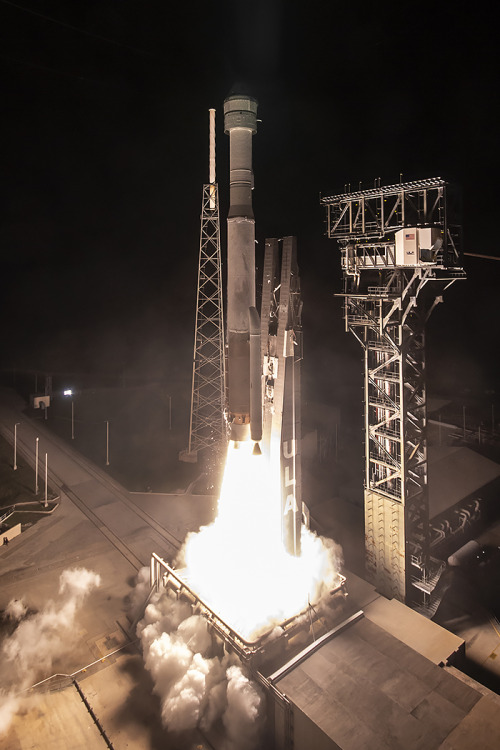Inaugural Starliner mission cut short as computer anomaly nixes ISS rendezvous. (December 21, 2019)B
Inaugural Starliner mission cut short as computer anomaly nixes ISS rendezvous. (December 21, 2019)Boeing’s CST-100 Starliner capsule launched on its maiden voyage to space Friday morning, beginning the final phase of testing before flying American astronauts aboard. However, shortly after being deployed from the Atlas V launch vehicle, a problem with the capsule’s Mission Elapsed Timer caused the spacecraft to enter the wrong orbit. This ultimately forced NASA to call off its rendezvous with the International Space Station and return to Earth at the earliest possible opportunity. Lifting off from Cape Canaveral’s SLC-41 at 6:36AM EST, Starliner’s ascent went according to plan, with separation of the twin AJ-60A solid rocket motors, core stage jettison, and aeroskirt jettison all occurring on schedule.Fourteen minutes after launch when the Centaur Upper Stage deployed the capsule in orbit is when the anomaly occurred. Starliner’s Mission Elapsed Timer - an onboard computer that controls the spacecraft’s automatic sequence of events – thought the mission was at a different point in space and a different point in the timeline.This caused the vehicle’s 20 Orbital Maneuvering and Attitude Control (OMAC) engines to fire for the full duration of the 40-second Orbital insertion burn nearly 14 minutes before it was actually supposed to happen. Controllers at Boeing’s Mission Control Center (BMCC) noticed the error and sent the spacecraft a new set of instructions. However, a brief gap in communications between Starliner and NASA’s Tracking and Data Relay Satellites caused the signal to never be received. Ultimately, Starliner burned 25% more propellant than was intended, forcing NASA and Boeing mission managers to call off Saturday’s planned rendezvous and docking to the International Space Station. At a postlaunch briefing, NASA Administrator Jim Bridenstein and Boeing’s Jim Chilton stated that Starliner would still perform a shortened orbital shakedown cruise before returning to the White Sands Space Harbor landing site early Sunday morning. Bridenstein stated that further analysis of the Mission Elapsed Timer anomaly would determine whether or not Boeing would need to fly a second uncrewed test before the crewed CFT-1 mission in 2020.Diagram of the Atlas V N22 launch vehicle. N22 denotes that Atlas will be flying without a payload fairing, two solid rocket boosters, and a dual-engine Centaur Upper Stage. Credit: Boeing.A unique launch profile and rocket. Starliner’s ascent to orbit was flawless. It was the first flight of the Atlas V N22 launch vehicle, which featured a number of upgrades to improve the vehicle for Human flight. An Emergency Detection System was installed to autonomously monitor the vehicle’s health during all portions of ascent, and could abort the capsule in the event of a malfunction. Additionally, a 1.8 meter aeroskirt was installed on the Launch Vehicle Adapter directly aft of the Starliner service module. This better streamlined the rocket’s aerodynamic profile during ascent and kept acoustic loads within safe parameters. In order to keep acceleration loads – known as G-forces – to a safe level for humans, Boeing required ULA to design a unique ascent profile for the rocket. All Atlas V missions with Starliner will see the vehicle ascend on a much shallower trajectory than normal Atlas V launches. This also means that astronauts are able to abort from the rocket at any portion of the flight, a requirement of NASA’s. To accommodate for the reduction in launch vehicle efficiency caused by this unique trajectory, ULA employed two RL-10 engines on a dual-engine Centaur Upper Stage for the first time. Dual Engine Centaur’s were commonplace on previous Atlas variants, with 166 flights between 1962 and 2004, but have never flown on an Atlas V. Once Centaur deploys Starliner 14 minutes and 55 seconds after launch, the capsule is just 80 kilometers per hour shy of orbital velocity. Sixteen minutes later, the spacecraft’s 20 OMAC engines fire for 40 seconds to provide the final kick to orbital velocity while simultaneously circularizing the orbit to an altitude of 181 kilometers.Below, a diagram of the CST-100 Starliner capsule showing the spacecraft’s major components. Credit: Boeing.Watch a replay of Boeing’s Starliner launch broadcast below:P/c: ULA/NASA. -- source link
Tumblr Blog : for-all-mankind.tumblr.com
#commercial crew#boeing#starliner#atlas v


